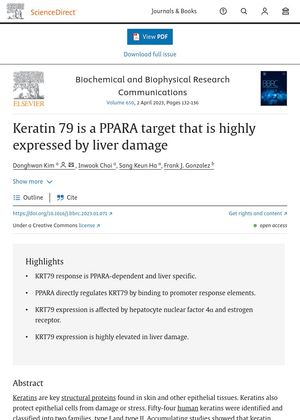TLDR Keratin 79 is linked to liver damage and may help diagnose liver diseases.
The study explored the role of Keratin 79 (KRT79) in liver damage. It was found that KRT79, typically associated with hair canal morphogenesis and regeneration in skin, is undetectable in a normal mouse liver but its expression significantly increases with the use of PPARA agonist WY-14643 and fenofibrate. This increase is completely abolished in Ppara-null mice, suggesting that hepatic KRT79 is controlled by PPARA. KRT79 expression also significantly increased in liver damage models induced by fasting and high-fat diet. The study, which involved 5 liver samples for each data point, concluded that KRT79 is a PPARA target gene and is highly associated with liver damage, suggesting its potential as a diagnostic biomarker for liver diseases.
 60 citations
,
November 2013 in “Development”
60 citations
,
November 2013 in “Development” Keratin 79 marks a new group of cells that are key for creating and repairing the hair follicle's structure.
87 citations
,
September 2012 in “Journal of Cell Science” Keratins are crucial for tissue strength, and mutations in keratin genes can lead to various diseases, highlighting the need for targeted therapies.
 438 citations
,
October 2010 in “Oncogene”
438 citations
,
October 2010 in “Oncogene” Keratins help protect cells, aid in cancer diagnosis, and influence cancer behavior and treatment.
 1398 citations
,
May 2008 in “Histochemistry and Cell Biology”
1398 citations
,
May 2008 in “Histochemistry and Cell Biology” Keratins are crucial for cell stability, wound healing, and cancer diagnosis.
686 citations
,
February 2002 in “Current Opinion in Cell Biology” Keratin filaments are crucial for cell structure and protection, with ongoing discoveries about their genes and functions.
38 citations
,
November 2020 in “International journal of biochemistry & cell biology” Keratin proteins are essential for keeping the cells in the human colon healthy and stable.
277 citations
,
October 1982 in “The Journal of Cell Biology” Basal-cell epitheliomas and the pilosebaceous tract share a unique keratin, distinguishing them from other skin areas.



